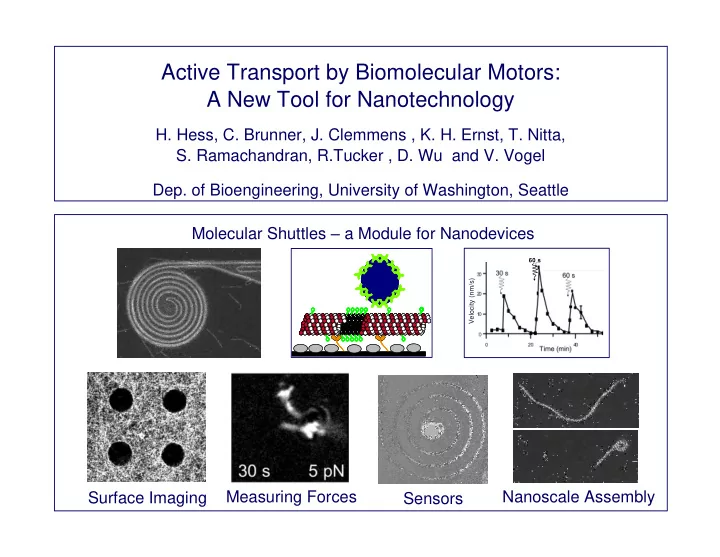

Active Transport by Biomolecular Motors: A New Tool for Nanotechnology H. Hess, C. Brunner, J. Clemmens , K. H. Ernst, T. Nitta, S. Ramachandran, R.Tucker , D. Wu and V. Vogel Dep. of Bioengineering, University of Washington, Seattle Molecular Shuttles – a Module for Nanodevices 60 s Velocity (nm/s) Measuring Forces Nanoscale Assembly Surface Imaging Sensors
50 nm Kinesin motor Fuel: 1 ATP per step Force: 5 pN per motor Speed: 100 steps/s of 8 nm Vesicle Kinesin Movie from Vale lab, UCSF N. Hirokawa, Science 279 , Microtubule 519 (1998)
Motor Proteins Mitosis – coordinated movement, positional control ~10 m Smith College, Dept. of Biology website Fast anterograde transport – transport of vesicles (D < 100 nm) through axons ( D = 1 m) 1 m G.A. Smith et al., PNAS, 98 ,3466-3470
Application: Diffusion: Active Pressure-driven < x 2 > = 2Dt fluid flow: v ~ d 2 transport Intracellular Mitosis Large scale transport – transport - effective diffusion Fast anterograde cardiovascular limits cell size transport system Nanofluidics Self-assembly – Microfluidic devices – upper limit Guided assembly for lateral limit for channel dimensions diameter Smart Materials
Basic experimental setup: Inverted motility assay J. Howard et al, Methods in Cell Biology 39 (1993) 137 Force: 5 pN per Kinesin Fluorescence microscope Objective Microtubule Flow out spacers Glass coverslip Casein Kinesin slide Speed: 800 nm/s at 1 mM ATP Flow in
Molecular Shuttles – a Nanoscale Transport System Cargo Shuttle system Delivery Engineering challenges: - Guiding along tracks Sorting - Control of movement Shuttle Cargo - Loading and unloading Transporting detail Loading Cargo Assembly Delivery Shuttle detail Linkers Cargo Microtubule – + Kinesin Track surface
Guiding channels Non-fouling surfaces Nanotechnology, 10 , 232 Surface Topography Nano Letters, 1 , 235 chemistry Langmuir, 19 , 1738 Guiding Adhesion Langmuir, 19 , 10967 Pattern Nano Letters, 3 , 1651 of motors layout Lab on a Chip, 4 , 83 Motor concentration Genetic engineering
Guiding: Combination of surface chemistry and topography Photolithography + Detergent to prevent Protein adsorption 1 m 10 m silicon silicon 20 m Adhesive: Photoresist Bare silicon SU8-2 Time Non-adhesive: F108 pluronic 50x [PEO 129 -PPO 56 -PEO 129 ]
Directional sorting is accomplished Guiding: by track geometry 20 m Time 50x H. Hess et al.: “ Ratchet patterns sort molecular shuttles ” , Appl. Phys. A 75 , 309 (2002)
“ Der Straßenbau “ - 1929 1916 – Patent on the “ clover leaf ” Woodbridge, NJ - 1928 http://members.a1.net/wabweb/frames/kreuzf.htm
Guiding: Complex track networks 100% “ Ring ” 3% 97% 33% “ Gothic ” 100% “ Baroque ” 10 m 67% Crossing junctions B inlet Tangential Reflector junction straight D Circular Orthogonal path concentrator outlet turning path microtubule trapped in reflector turning straight centre loop arm path microtubule path turns around J. Clemmens et al.: “ Motor-protein “ roundabouts ” : Microtubules moving on kinesin-coated tracks through engineered networks, Lab-on-a-Chip 4 , 83 (2004)
Molecular shuttles image surfaces 20 m Microtubule 1 m Poly- urethane Casein Kinesin inaccessible accessible Nano Letters 2 , 113 (2002) 500 frames observed in 2500 s 20 m
Biological Analogue: T cell trafficking M. J. Miller, et al.: “ Autonomous T cell trafficking examined in vivo …” , PNAS 100 , 2604 (2003) m m 25 m m Intravital imaging of vessels (red) and T cell perform Random Walk to cells (green) in a living lymph node sample local landscape of antigens
Control of UV light 60 s pulses movement: Velocity (nm/s) ATP conc. reduced by added hexokinase Caged ATP is released by UV light 10 m 1 s movie = 300 s real time
Loading / H. Hess, et al., Nano Letters, 1, 235 (2001) unloading: Selective binding of cargo: Selective binding of cargo: Streptavidin-coated cargo Streptavidin-coated cargo Microtubules Microtubules with biotin-linkers with biotin-linkers Kinesin-coated Kinesin-coated surface surface
H. Hess, J. Howard, and V. Vogel: A piconewton forcemeter assembled from kinesins and microtubules, Nano Letters, 2(10), 1113 (2002) 5 m 1 s movie = 50 s real time
A piconewton forcemeter:
Lifetime of bionanodevices: A benchmark (1) Kinesin motors are dimeric proteins undergoing large conformational changes (2) Microtubules are supramolecular assemblies of the protein tubulin, their natural equilibrium between assembly and disassembly is affected by the stabilizing anti-cancer drug taxol (used in our devices) (1) Kinesin motors remain active for at least disassembly # of MTs per FOV 1-2 days at room temperature. (2) Microtubules have a lifetime of ~12 hours. (3) The ATP fuel lasts for ~10 days. Microtubules are the weak link! breaking Glass cell More aggressive stabilization by chemical cross-linking required. time [h] C. Brunner, K.H. Ernst, H. Hess, V.Vogel: “ Lifetime of biomolecules in hybrid nanodevices ” , Nanotechnology 15 , S540 (2004)
Lifetime of bionanodevices: Packaging materials Cover: Microfabricated, transparent, inert Materials scan: Glass, PDMS, PMMA, PU, EVOH In the absence of intense illumination: Microtubule lifetimes of several hours Under illumination in the fluorescence microscope: Rapid decay for PDMS, glass cell without oxygen scavenger Patterned surface: Well-characterized materials O 2 permeability affects compatibility (photoresist, glass) in contact with motors C. Brunner, K.H. Ernst, H. Hess, V.Vogel: “ Lifetime of biomolecules in hybrid nanodevices ” , Nanotechnology 15 , S540 (2004)
Molecular Shuttles – a Module for Nanodevices 60 s Velocity (nm/s) Surface Nanoscale Biosensor Imaging Forcemeter
Acknowledgements: The UW molecular shuttle team: Viola Vogel Jonathon Howard (until 2002) John Clemmens, Robert Doot, Christian Brunner, Karl-Heinz Ernst Robert Tucker, Sheila Luna, Di Wu, Sujatha Ramachandran Scott Phillips The SNL motor team: Bruce C. Bunker George D. Bachand Carolyn M. Matzke, Susan B. Rivera Andrew K. Boal, Joseph M. Bauer Kinesin expression: Mike Wagenbach & Linda Wordeman Non-fouling surfaces R. Lipscomb, Y. Hanein, by plasma deposition: B. Ratner, K. Böhringer Funding: NASA, DOE-BES DARPA Biomolecular Motors Program
Microfluidics versus Nanofluidics Baas, Microscopy Res. Techn. 48, 75 Channel diameter: 50 m vs. 500 nm 500 nL sample Sample 50 m volume: 500 nL vs. 10 fL Flow velocity: 1 mm/s vs. 1 m/s
Recommend
More recommend